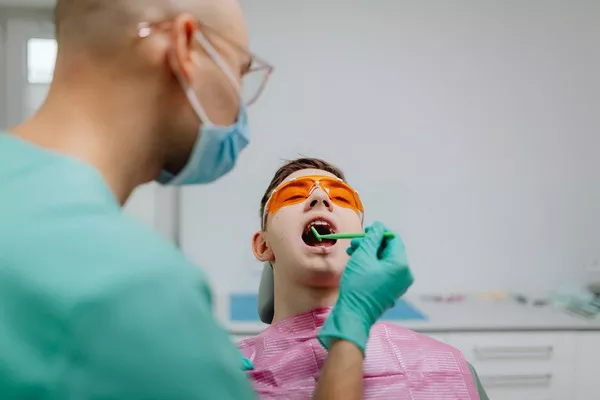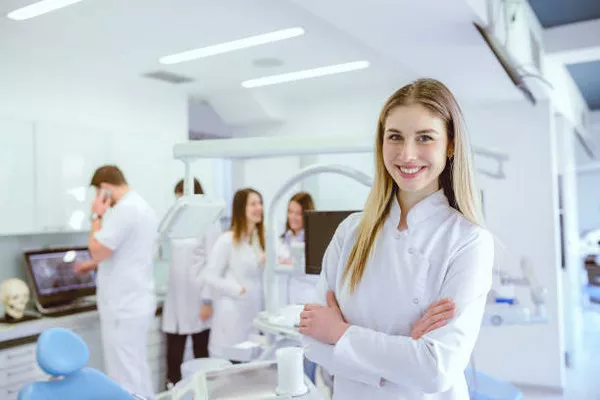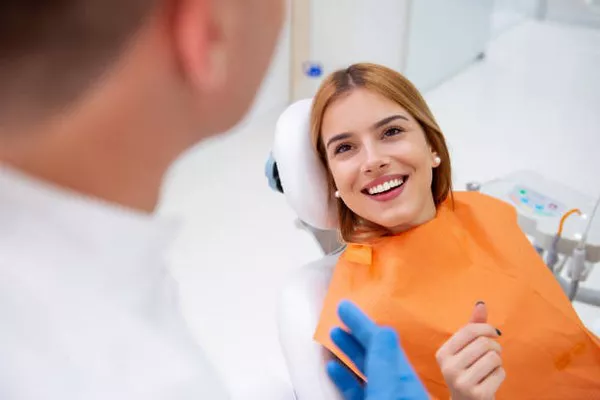Abstract: Objective: To introduce the orthodontic treatment before and after operation and preoperative preparation of 10 patients with bone reverse deformity treated by orthodontic-orthognathic surgery.
Methods: ORTHODONTICS IS mainly to compensate, to correct the lip and tongue tilt of the upper and lower anterior teeth and the buccal tongue tilt of the posterior teeth, to align the teeth, to coordinate the upper and lower dental arches, to smooth the curve, to establish a good dental relationship before orthognathy.
Preoperative preparation is mainly: preoperative computer simulation of surgery, simulation of surgery, board production.
Results: After orthognathic treatment, the patients established a good relationship between bite and jaw, coordinated relationship between upper and lower jaw, and obtained the beauty of face.
Conclusion: THE TREATMENT OF MAXILLOFACIAL BONE DEFORMITIES, after the process of preoperative ORTHODONTICs-ORTHODONTIC SURGERY-postoperative ORTHODONtic, each step is very important, preoperative computer simulation surgery, model surgery, plate making can make orthoGNATHic treatment more accurate.
Severe osseous deformity in adults is due to overdevelopment of the mandible, but may also be accompanied by maxillary hypoplasia, a concave deformity of class III malocclusion.
Such deformities lead to abnormal shape of face, and upper and lower dental arch vicarious wrong cannot adopt the method of treatment for orthodontic alone, also can’t separate the positive jaw surgery therapy for orthodontic change growth is limited, rely on the tooth compensatory cannot correct face abnormal morphology, and jaw surgery after correct the relationship between jaw position, which cause more severe fluctuation tooth bow to be not moved,
Due to the high recurrence rate, only orthognathic-orthodontic combined treatment can achieve the therapeutic purpose of perfect combination of morphology and function [1] and stable curative effect.
The purpose of this article is to summarize and discuss the cases of orthognathic orthodontic treatment.
1 Clinical data 1.1 Case diagnosis All patients were outpatients of our hospital and required correction of concave deformity.
According to the clinical examination, model analysis, X-ray cephalometric analysis and other data of the patients, the diagnosis was made, and the preoperative orthodontic plan, surgical method, namely the treatment goal, was determined.
1.2 Case data Ten patients were admitted to our department recently, including 9 females and 1 male, with an average age of 19.9 years (range, 17-23 years).
Two of them had maxillary hypoplasia and underwent modified Le Fort I maxillary anterior migration.
Two patients with mandibular hyperplasia and maxillary hypoplasia were treated with a modified maxillary Le Fort I maxillary anterior migration.
Six patients with mandibular hyperplasia were treated with sagittal split and retraction of the ascending ramus of the mandible. All patients were orthodontic before operation.
Three patients did not undergo postoperative orthodontics.
All orthodontic treatments were performed with square wire arch correction technique. The patient data are shown in Table 1.
Table 1 List of case data No. Gender Age Malformation location Preoperative orthodontics Postoperative orthodontics 1 male 17 mandibular mandibular 192 female 17 maxillary maxillary 1583 female 20 maxillary maxillary 2464 female 23 bimaxillary bimaxillary 2485 female 20 bimaxillary bimaxillary 256 female 21 mandibular 18127 female 23 mandibular mandibular 20138 female 20 mandibular 209 female 1
8 Mandible 21610 female 20 mandible 982 Steps and methods 2.1 Common oral deformities in adult orthodontic patients before surgery include: upper incisor lip tilt, lower incisor tongue tilt, upper posterior teeth buccal tilt, lower posterior teeth tongue tilt, upper dental arch crowding, upper dental arch smaller than lower dental arch.
In all cases, orthodontics before surgery included the following.
2.1.1 Narrow the width of the upper posterior arch and expand the width of the lower posterior arch.
In this paper, all patients need to correct the tilt of the posterior teeth. Due to class III malocclusion, the basal bone arch of the posterior teeth of the mandible is larger than that of the maxillary posterior teeth, resulting in dental compensation. When the jaw is adjusted to a normal position, the posterior teeth become positively locked, so the long axis of the posterior teeth must be corrected before the operation.
The design of the treatment: ¢Ù The posterior teeth were used as interactive traction, that is, the brackets and lingual buttons were glued to the buccal side of the maxillary molars and the lingual side of the mandibular molars, and the 3/8 rubber band was used for interactive traction, which was replaced once a day.
The upper and lower jaw models were taken every two weeks, and the models were positioned to the postoperative position to observe the occlusal situation of the posterior teeth. If the surface contact was reached, the long axis of the posterior teeth was controlled by square tube with ring and square wire.
(2) Square pipe with ring, square wire at the end of the production of positive axis Angle.
For less serious posterior teeth, good results can also be achieved by using square wire end plus positive axis Angle and continuous ligation between two bicuspid teeth after extrusion of dentition.
The phase model is still taken during the positive axis to control the degree of the positive axis.
2.1.2 Correction of anterior teeth compensation.
There is compensation of anterior teeth in adult inversion, anterior teeth lip tilt, lower anterior teeth tongue tilt.
After orthognaplasty, when the relationship between the upper and lower jaw is normal, the upper and lower anterior teeth have no normal overlying relationship, and the anterior teeth cannot be cut off. Therefore, the compensation and correction of the anterior teeth is very important.
All patients in this study had compensatory tilt of the upper and lower anterior teeth, which was corrected with a square wire arch appliance.
In the treatment, attention should be paid to the coordination between the basal bone mass and the tooth volume of the maxilla. If the maxillary dentition is crowded and the tooth volume is larger than the basal bone arch, the tooth extraction should be considered, and the maxillary extraction should be used to align the teeth with the gap, and the vertical upper incisors should be adducted so that they are aligned to the top of the basal bone arch with a normal inclination Angle.
When the upper jaw needs to be extracted for compensation, the lower jaw should also be extracted to make the Botten index of the upper and lower dental arches normal.
In this paper, the mandibular extraction uses the gap to adjust the position of the first molar, so that the upper and lower jaw can be moved to achieve a neutral Angle’s relationship.
In compensation for the removal of the upper and lower anterior teeth, the anterior teeth move towards the tongue.
The lower anterior incisal margin moves to the lip side, causing greater recurrent cover, which may cause concern for the patient. This should be explained to the patient prior to treatment.
2.1.3 Coordination and adjustment of the upper and lower dental arches This step is to ensure a good apical and concave correspondence between the upper and lower dental arches and normal overlaying of the front and rear teeth after orthognathic surgery.
In this paper, models were taken after each treatment stage for research, and the upper and lower mandibular models were matched to the position after surgery to observe whether the radian of the anterior segment of the upper and lower dentition was in harmony with the width between the cusps, the width of the posterior segment, the relationship between the first molars, and whether individual cusps were beyond or below the plane.
According to the problems FOUND, DIFFERENT curves or some auxiliary ARCHES were made IN the corresponding part of the arch wire for individual tooth adjustment, and several horizontal curves were also used for three-dimensional adjustment of individual teeth.
2.2 Preoperative preparation The coordination of the upper and lower dental arches can be achieved through the matching observation of the models at each stage. When the compensation of the front and rear teeth has been removed, the preoperative preparation for orthognathism can be carried out.
2.2.1 VTO prediction (computer simulated surgery) : Visual Treatment Objective (VTO) prediction was performed before and after orthodontic Treatment for all patients in this paper.
It is through a computer system, the patient’s head positioning lateral film and the same positioning lateral profile picture input computer, registration overlap, and then simulate the operation.
The mandible can move and rotate in two dimensions in sagittal and vertical directions.
When the bone mass moved to the ideal position, the soft tissue was then covered on the surface of the jaw in a certain proportion to obtain the postoperative lateral image of the patient.
The computer procedure can be repeated until a satisfactory profile is obtained for both the patient and the patient.
The pre-orthodontic VTO can provide the best profile of the jaw movement data to guide the placement of the model at each stage of orthodontic treatment.
Avoid bad looks or bad bites caused by blindly moving the jaw.
VTO prediction after orthodontic treatment and before surgery can provide more accurate distance and Angle of bone mass movement, which can guide model surgery and actual surgery.
2.2.2 Model surgery: ¢Ù The upper and lower jaw model was taken and anhydrous plaster was applied.
¢Ú The relationship between maxillary bone and skull base was recorded from the mouth of the patient with facial arch and transferred to the Hanas frame.
¢Û The condylar long axis Angle of the scaffold was set as an average of 10¡ã, and the condylar conductance was the same as the incisional conductance of the patient.
¢Ü Determine the position of the mandible with an occlusal wax tablet that records the relationship between the upper and lower jaws.
¢Ý Five vertical lines were carved on the upper and lower models: through the midline, the cusp, and the mesial buccal apex of the first molar. The vertical distance of each vertical line from the cusp to the bottom plate of the frame, and the horizontal distance from the midline to the guide needle in front of the frame were recorded.
After the above preparation, the upper and lower jaw model can be moved to the ideal position and fixed under the guidance of the data obtained from the VTO prediction.
Then, simple forward extension and lateral movement were performed on the frame to find out the obvious interference, and appropriate grinding was done. The grinding cusp should be marked to guide the intraoral grinding of the patient. 2.2.3 Closing plate: After the completion of model surgery, the upper and lower jaw model was removed about 1mm.
A wax strip with a width of 2mm and a thickness of 2mm was applied to the tooth surface along the high contour line on the buccal and lingual side of the dental arch, and the tooth surface was firmly glued. The concave cavity between the abduction gap and adjacent space was filled with wax, so that the apex and incisal edge of each tooth were exposed about 1.5mm.
Apply a separating agent to the exposed tooth surface.
Form a horseshoe-shaped rope with the self-setting plastic from the early stages of the dough and place it in the jaw
































